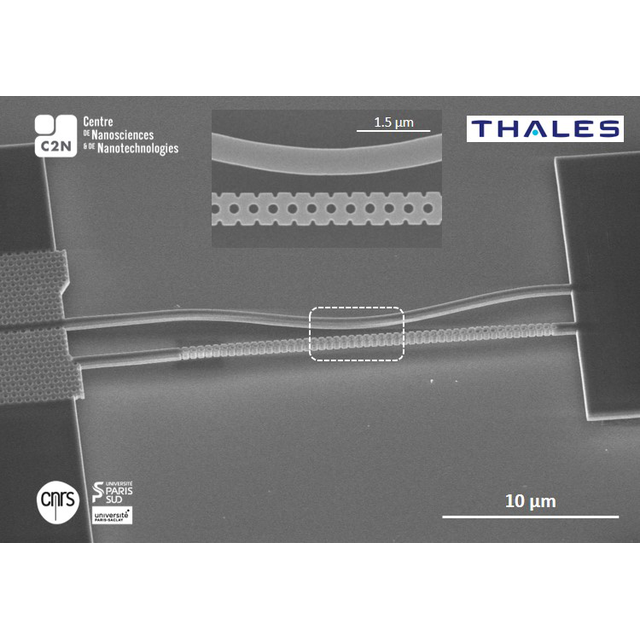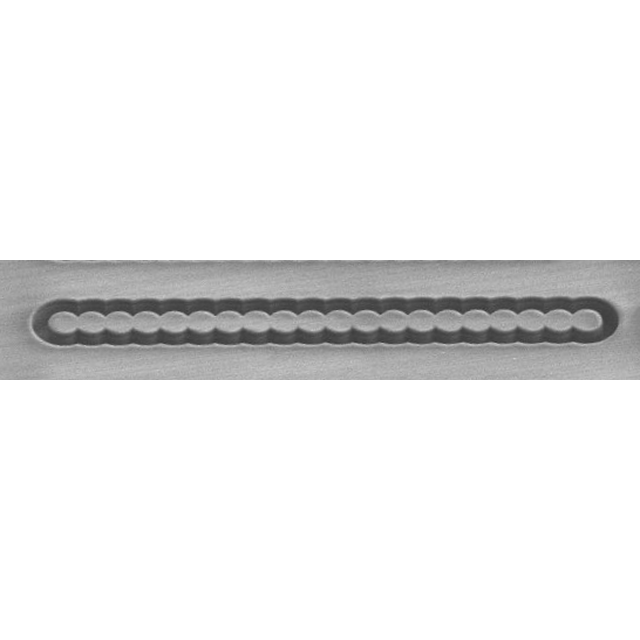A team of physicists at C2N and Thalès Research and Technology have demonstrated an optomechanical oscillator, based on an ultra-compact bichromatic one-dimensional crystal, able to operate at 3 GHz at room temperature.
Oscillators are devices able to produce a periodic signal of high purity, and are used in many industrial fields and many everyday applications. However, they generally operate poorly at low frequencies, with poor phase stability or necessitating a fairly large architecture. For applications in the fields of telecommunications or satellite positioning, oscillators in the GHz frequency range are key basic elements. Demonstrating a compact oscillator, able to operate at these frequencies while maintaining high stability, has remained a challenge until now. Optomechanical resonators, which exploit the interaction between an optical mode and a mechanical mode, confined and collocated at the center of the resonator, have been actively studied in recent years and can address all of these challenges.
In this context, researchers at C2N, in collaboration with Thalès Research and Technology, developed optomechanical structures made of InGaP* using a concept of nanoengineering based on a bichromatic one-dimensional optomechanical crystal. The optical reading of the Brownian motion of these ultra-compact structures under atmospheric conditions makes it possible to highlight mechanical modes close to 3 GHz, with a mechanical quality factor at the state of the art (a few thousand). These results have been published in APL Photonics.
Under these conditions and for a free-running resonator (without external feedback loop), self-sustained optomechanical oscillations are systematically obtained directly at the mechanical frequency with a low driving optical power threshold of the order of 40 μW. The linewidth of the mechanical mode is then reduced to 100 Hz. Indeed and in accordance with the phase noise measurements, the spectral purity of the mechanical mode is enhanced by about a factor 10000.
These optomechanical crystals have a unique potential to become ultra-compact stable microwave oscillators with properties comparable to the state of the art but directly in the GHz frequency range and without resorting to frequency multiplier stages, with the advantage of providing an additional optical output, convenient for on-chip signal distribution. Moreover, these devices made of a piezoelectric material can be equipped with piezoelectric transducers and hybridized on a photonic silicon circuit in order to be used for microwave conversion in optics and for more elaborate miniaturized optoelectronic oscillators with self stabilization schemes.
* Semiconductor in Indium / Gallium / Phosphide. The low optical losses due to low two-photon absorption and its piezoelectric properties make it a valuable material for optomechanics and other photonics applications.
References:
Optomechanical Gigahertz Oscillator made of a Two Photon Absorption free piezoelectric III/V semiconductor,
I. Ghorbel1,2, F. Swiadek2, R. Zhu1, D. Dolfi2, G. Lehoucq2, A. Martin2, G. Moille2, L. Morvan2, R. Braive1, S. Combrie2 & A. De Rossi2
APL Photonics, November 2019
DOI: https://doi.org/10.1063/1.5121774
- Centre de Nanosciences et de Nanotechnologies – C2N (CNRS/UPSaclay)
- Thales Research and Technology, Palaiseau, France
Contact:
- Rémy Braive, Assistant Professor Université de Paris at C2N
- Ines Ghorbel, PhD Student at C2N and Thalès TRT
Figure: (Side view) Scanning electron microscope image of the suspended optomechanical cavity. (View from above) Focus on the center of the cavity confining both optics and mechanics. The holes in the center and the indentations at the edges of the beam with a different periodicity induce the bichromatic character of the confinement. Copyright C2N/Thalès TRT









